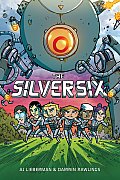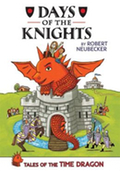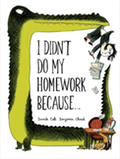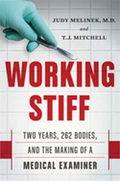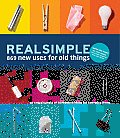Link to this review in the form of a comic strip by geneambaum tagged science fiction

Click for the full-sized comic
@bookblurb Astronaut Mark Watney was left behind on Mars during an emergency evacuation, and has to figure out how to survive.
Link to this review by geneambaum tagged graphic novel • science fiction
Twelve-year-old Phoebe’s parents died a year ago. She’s managed to stay in school and keep her home with the help of her robot, Max. After an agent of energy giant Craven Industries comes looking for her for unknown reasons, Child Welfare Services puts her into a high-tech orphanage. It’s a miserable place where kids do three things: eat, work, and study. The only thing worse than the teachers is the food. But it’s there that she makes five friends with something in common: they each have a Moon Registry certificate signed by Phoebe’s father. They team up, escape the orphanage, and fly to the moon on their certificates where, with the help of Max, they figure out the truth about their parents’ deaths and why Craven Industries is hunting them down.
Why I picked it up: My daughter said it was good.
Why I finished it: I love the wisecracking robot, Max, who is something of a screwup. When Phoebe is late for school, she blames Max, who responds, “I’ll have you know that those words are both cruel and insensitive.” He loves pancakes and pizza. And he proves that he’s a friend and not just a possession when he sacrifices himself to help the kids.
Readalikes: The Mysterious Benedict Society, which is also about adventurous and smart orphan kids and their adventures. And all of Jonathan Hickman’s run on FF, about a team of superpowered and super smart kids (under the supervision of the Fantastic Four) who have food fights and try to solve the world’s problems.
@bookblurb In a high-tech orphanage, Phoebe makes 5 friends who also have Moon Registry certificates.
Link to this review by snow tagged science fiction • history • picture book
Joe and Lilly have to do a report on the Middle Ages. When they go to the library computer to start their research, they are pulled back in time by Red the Time Dragon. But is hanging out with a dragon in England in 1200 the safest way to learn history?
Includes a map, a glossary, more information about the Middle Ages, and a timeline.
Why I picked it up: When I was a kid I loved Eve Bunting’s Dinosaur Machines series, where a group of kids discover a lever in a museum display that tosses them back to the time of the dinosaurs. For me, dragons trump dinosaurs, so this was a must-read.
Why I finished it: Neubecker’s vividly colored, cheerful art. When the kids and Red walk through a dark forest, grumpy bears, eagles, deer, wolves, and peasants peek out from behind the trees. The tiny, scowling faces made me giggle. He didn’t skimp on detail when drawing a cathedral and gave it just the right sense of majesty. Neubecker’s writing is simple and easy to follow. He doesn’t explain everything about the Middle Ages, he simply shows just enough to capture readers’ interest and inspire them to find out more on their own.
It’s perfect for: My mother’s friend Anndrena, who has spent her life fighting for unions and workers’ rights. She’d be tickled that the dragon convinces the peasants to stand up to the evil landowner.
@bookblurb Joe and Lilly travel back in time to England in the 1200s to learn about history.
Link to this review by danritchie tagged coming of age
Jonas is an all-league point guard in rural Redwood City, California, who has hopes of getting a Division II college scholarship. When his dad loses his job, the family relocates to Seattle to work for his brother. Jonas isn’t even sure he’ll make the Harding High team.
On the day they move in, Jonas meets Levi Rawdon, Harding High’s starting forward. Levi is worried about making the team, too, but his troubles are academic. He has a gift for art, but doesn’t connect in the classroom. They spend the summer and early fall playing pick up games and shooting around at the community center. They hook up with Ryan Hartwell, who works with them on the skills. When the season starts, Hartwell is hired as assistant coach, and he takes on tutoring Levi. Jonas makes the squad, but spends the first half of the season with very limited playing time. After the head coach falls ill and Hartwell takes over, Jonas is given his chance.
Then Levi quits tutoring. He tells Jonas that he’s been sexually abused. Jonas wants to help Levi, but if he does his hopes for the future could come crashing down.
Why I picked it up: Local author Deuker is one of my favorites. His use of sports as a vehicle to show young men dealing with social issues is always well done and realistic.
Why I finished it: Jonas’s evolving relationship with Levi. They initially connect on the court, but as Jonas gets to know Levi and his devotion to his faith, his family, and nature, he begins to realize that there is much more to success than basketball. For Levi, his love of his younger sisters and protecting his oldest sister from their father’s wrath mean much more that basketball.
It’s perfect for: Ryan, who is a sports junkie raised in a strict, religious family, who grew to embrace his faith. He will identify with Levi’s positive, calm personality and the bond that grows between the two young men.
@bookblurb Jonas joins his new school’s basketball team and becomes friends with Levi, who has been sexually abused.
Link to this review by geneambaum tagged graphic novel • humor
A young boy explains to his teacher why he didn’t finish his homework.
Why I picked it up: The fantastic cover illustration of a crocodile (or is it an alligator?) picking up a boy (he’s trying to do his homework) while his frightened dachshund hides. And I liked the advice on the back cover: “Caution: Each excuse may only be used once.”
Why I finished it: The illustrations for each excuse are hilarious The dog is present in most of them, too. In “Elves hid all my pencils” the elves are hiding under the table where the boy is trying to study. Pencils poke out of their hats, mouths, ears, and noses as they silently make faces at each other. In “A rebellious robot destroyed our house,” his mother is attacking the robot with a lamp and the boy is risking his life in an attempt to retrieve his homework from its hand. The house is in pieces but his father is still in his chair reading a newspaper, oblivious to the carnage.
It’s perfect for: Richard, who would like the Edward Gorey-esque illustration for “We ran out of firewood, so I sacrificed my workbooks to stay warm.” The dad and the dog are both wearing top hats, and the family is cooking hot dogs over a burn barrel in their fancily furnished living room.
@bookblurb An illustrated guide to excuses for not having finished your homework.
Link to this review by flemtastic tagged history • biography
Conrad Hilton became a hotelier by chance, when his family was struggling during a financial panic in 1907. He suggested opening up rooms in their house for rent. Against the odds, it worked, possibly giving Hilton the idea that would make his fortune. Within a few years, he was deep into real estate in Texas, running several hotels. After he had become a socialite and wealthy businessman, he was captivated by the beauty of a young Zsa Zsa Gabor; they married after a whirlwind romance. They couldn’t have been more mismatched, and their marriage was quickly over, although Zsa Zsa hung around for decades. As Conrad got older, he remained active in the hotel business, but began to consider a successor, either his son Barron or his younger son Nicky. An unstated competition sprang up between the brothers that lasted throughout their lives. Both worked for their father, managing hotels, and later, entire divisions of Hilton. When Conrad passed, there were lawsuits over the provisions of the will. The newest generation of Hiltons includes Paris, who became famous for a sex tape with a former boyfriend.
Why I picked it up: Books about dynastic families have proved interesting in the past, so I was willing to give this one a try. It sounded like a book I reviewed recently about the Johnson family of Johnson & Johnson medical products fame.
Why I finished it: Details about playboy Nicky’s love life, like when he was seeing two Hollywood starlets at the same time, Natalie Wood and Joan Collins! And this is after a brief, tumultuous marriage to Elizabeth Taylor when he was younger and more naïve. Conrad, a devout Catholic, was tortured about divorcing Zsa Zsa and not being able to have a Catholic wedding with his second wife. In fact, even though he was a suave public speaker and businessman, he was so out of his depth and uncomfortable talking to Zsa Zsa about their marriage that he asked his local priest to do it for him.
It’s perfect for: My friend Patti, who travels quite a bit for business. She has also told me that she prefers staying at Hilton hotels because they really are better, both in amenities and service. She would appreciate the stories in this book about Conrad Hilton’s attention to detail and desire to make his guests’ stays special. Apparently this still guides the chain years after his death.
@bookblurb The story of hotel mogul Conrad Hilton and his (sometimes) out-of-control family.
Link to this review by flemtastic tagged science • biography
Judy Melinek, a wife, mother, and medical examiner, keeps running into the same issue: she wants to describe the more interesting dead bodies to her husband at the dinner table. (Her husband struggles with this.) She is fascinated by the man whose head was crushed by a falling crane because he showed no apparent injury. Her husband is not.
Melinek went through two years of training to become a coroner, years during which she saw every kind of strange death imaginable. She shares details of how a medical examiner is trained, what various tests can reveal, and the limitations of the science. The job is much less glamorous than television shows would have you believe, but Melinek claims that bodies never lie. After starting work in New York just months before the 9/11 attacks, Melinek participated in identifying bodies and body parts at the World Trade Center site in order to return the remains to loved ones. Equally as comfortable in describing how a suicide determination is made as she is explaining how to use pruning shears to snap a ribcage open, Melinek tells all about a job she finds rewarding.
Why I picked it up: I am always up for a good book about strange jobs and the body, like Mary Roach’s Stiff: the Curious Life of Human Cadavers and Gulp: Adventures on the Alimentary Canal. This one promised real-life, CSI-type cases with disgusting details.
Why I finished it: Tons of gruesome facts. Melinek finds a body that had been dead for a week, with hundreds of maggots on the floor around it. She couldn’t help but step on them when approaching the body. Maggots inside the clothing made it wriggle.
She also reveals the surprising amount of “hardware [metal from piercings] that people are toting in their knickers.”
It’s perfect for: My brother in law, who loves Dirty Jobs. That show relishes the gross details about a particular job. This book could easily be the script for a show on coroners. Every aspect of a medical examination, from the time a body enters the morgue to the time it leaves, is covered in detail.
@bookblurb A medical examiner explains the limits of forensic science, and tells of interesting dead bodies she’s seen.
Link to this review by emilyreads tagged essays • biography
Novelist and Christian essayist Lamott offers a brief meditation on the ways we manage to keep going when life swats us down. Why do bad things happen to good people? How do we heal from the deepest wounds? Why do we bother? Neither screed nor pablum, Lamott’s five chapters on faith, pain, and forgiveness shine light on the divine within our messy humanity.
Why I picked it up: I’ve been an Annie fan for years, and the slim size of this one meant I could devour it in one afternoon with a gingerbread latte by my side.
Why I finished it: Did the thread/stitch metaphor get a little labored at times? Sure. But Lamott was always thoughtful and challenging, and I knew I’d close the book with some new insight (in this case, the pithy but hopeful assertion that “most of the time, love bats last”).
It’s perfect for: My mother-in-law, a devout and fun-loving woman who’s seen her share of crap. Consider it as a stocking stuffer for the seekers in your life.
@bookblurb Essayist Anne Lamott meditates on the ways we manage to keep going when life swats us down.
Link to this review by darcy tagged nonfiction
This encyclopedia of ingenious ways to reuse old items covers everything from accordion folders to zippered plastic bags.
Why I picked it up: I come from embarrassingly frugal stock. My family finds ways to reuse everything, so this book immediately appealed to me.
Why I finished it: Great ideas from using a jump rope instead of a ribbon on a gift box to using old cassette cases to hold your ear buds. The page on dental floss alone had me excited; it can be used to string beads on a broken necklace, to hang a picture, and to slice hard-boiled eggs. My favorite, though, was to take a picture of a plain white wall with a digital camera. In case of power outage, bring up the picture on your camera to use as a flashlight. (It works, though I still prefer my Maglite.)
It’s perfect for: My great aunt Rae. She used to use an old railroad battery to ripen her bananas. (Most people use paper bags, but jars work, too. The glass battery jars were tall enough to keep the ethylene gas near the bananas and accelerate ripening.) I know she’d love the ideas in this book, especially using a tackle box to store sewing supplies and using an upside down muffin tin as a cooling rack for pies.
@bookblurb An encyclopedia of ingenious ways to reuse old items.

